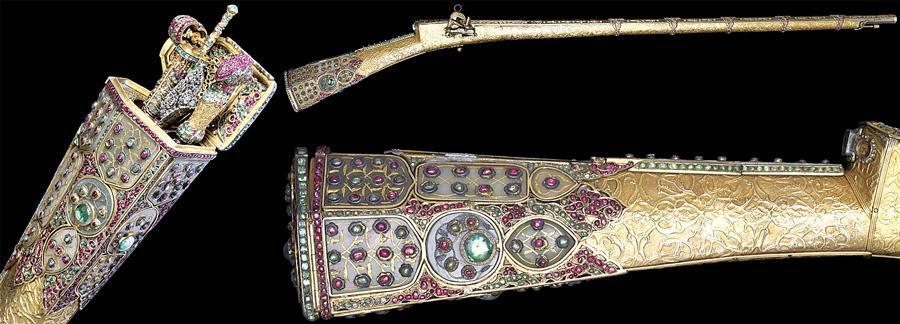
The unique ceremonial rifle of Sultan Mahmud I is on display at the Walters Art Museum in Baltimore, U.S. I have never seen a news about this unique rifle in our media. When I clicked on a website sent by a retired ambassador friend of mine, the splendor of the rifle captivated me.
Rifle with steel and wooden body is decorated with gold, gilt silver, silver, jade, diamonds, emeralds, pearls and rubies.
It is surprising that various objects are placed in the hidden compartments of the rifle’s butt and barrel.
When the butt, which is covered with various jewels, is opened from the back, the signature of Mahmut Sultan I, which is made with diamonds, next to the Hijri calendar 1145 (1732-1733) is seen.
When the upper part of the butt is opened, a jeweled writing set, a reed pen and a pocket knife are seen. There is also black ink from the lamp heat, cotton, wool and silk cloth against possible contamination and a unique ceremonial dagger in the lower part.
Behind the barrel, there is a rifle cleaner, a key, a spoon of gunpowder and the inscription of “mashallah.”
It is understood that the rifle was made jointly with a gunman, jeweler, key-maker, watchmaker and knife maker with the directions of the chief jeweler of the palace and the Armenian master Ohannes Ağa.
In the 19th century, William T. Walters, who made a great fortune in the fields of liquor, bank and railway (Photo 10), was interested in European and Asian art and made a collection in this field.
His son Henry Walters, who inherited the heritage, expanded the collection with manuscripts, weapons and armor and Islamic, Russian and ancient Near Eastern work of arts.
He opened the Walters Art Gallery in 1934. This museum in the city of Baltimore on the east coast of the U.S. displayed this magnificent rifle. In 2016, the rifle was displayed in the Asian Art Museum in San Francisco on the west coast.
Some Ottoman rifles, which are not that magnificent, were handed over to Ankara in 1928 from the Topkapı Museum.

Among them is a rifle with ivory inlay and silver butt, (Photo 12) and a mosaic embroidered rifle with gold barrel.
The Culture and Tourism Ministry probably is informed about this rifle in the U.S. and is trying to get it into the Topkapı Museum.
Sultan Mahmud I (1696-1754)
His father is Sultan Mustafa II and his mother is Saliha Valide Sultan. His grandmother Gülnuş Sultan raised her grandchild with love. From a young age he took lessons from various teachers. He engaged in history, literature and poetry. He used the pseudonym “Sebkati” (Advance) in his Arabic poems. He especially dealt with music.
He became a sultan at the age of 34 in 1730. He selected the most valuable people of his time and employed them. He was a characterful, determined, kind, compassionate, attentive and patient person. He acted thinking of the welfare of his nation more than his own pleasure.
In the early days of his sultanate, he had to fulfill the wishes of the rebels who raised him to the throne. Patrona Halil, the leader of the rebels, declared his loyalty to Sultan Mahmud I. However, he continued to intervene in state affairs. He even asked him to make him the head of the janissary and open a war against Russia. The sultan had Patrona Halil and his followers killed in the sixth week of his accession to the throne.
He suppressed the rebellion of the supporters a year later. He stopped the unproductive period of the state for a while.
He spent the last two years of his life sick. After a Friday prayer, he fell ill on his horse before falling into a coma.
He was pronounced dead and buried alive. The tomb keeper, who read Qur’an in his tomb at night, heard noises from the tomb and informed the palace.
His brother Osman, who succeeded him, did not mind this news. Nobody saw the tomb keeper again.